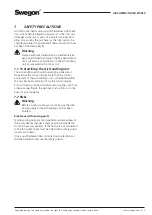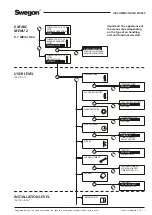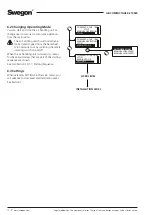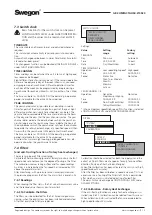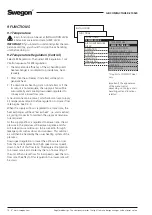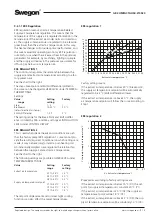
GB.COMPACTAHSK.210520
Registered design. The company reserves the right to make design changes without prior notice.
4 www.swegon.com
2
GENERAL
2.1 Field of Application
The COMPACT Air and COMPACT Heat units are complete
air handling units that can be installed directly in the room
to be ventilated. The ducts for outdoor air and exhaust air
should be connected to the top of the unit and should be
arranged to lead out through the wall. Other than that,
you need only connect the unit to the mains electric sup-
ply.
The installation work can be carried out very quickly and
easily and if the task of cutting openings through the wall
is not complicated, the unit can be operational in just a
few hours. It is also simple to relocate the air handling
unit if the nature of the activities conducted in the room
changes.
The ventilation is very effective thanks to the displacement
air distribution method used. The built-in control equip-
ment has several functions for economic operation.
The COMPACT Air and COMPACT Heat units are designed
for comfort ventilation and can be used in classrooms, day
nurseries, conference halls, smaller offices, workrooms,
shops, restaurants and similar public premises.
The difference between the COMPACT Air and the COM-
PACT Heat units is that the COMPACT Heat units can also
be used for heating.
It is important keep all the special characteristics of the
air handling units in mind when planning them into the
project, installing, adjusting and operating them to fully
obtain all the benefits the COMPACT system has to offer.
The unit must be installed indoors.
The COMPACT units are designed and tested for ambient
temperatures from -25°C to +40°C, and air stream tem-
peratures from -40°C to +40°C. However, for the rotary
heat exchanger the temperature difference between the
outdoor air and extract air must not exceed 70°C.
Important!
Always read the safety precautions in Section 1 that
explain the risks involved in running the unit and
designate who shall be permitted to operate and
service the unit, and carefully follow the installation
instructions provided in each paragraph.
The product identification plates are located inside the
room unit and on the unit’s rear side. See Sections 2.5.1
and 2.5.2 respectively. Refer to the particulars on the
product identification plate when you contact Swegon.
2.2 Mechanical Design
The COMPACT is available in one physical size and for two
airflow ranges.
Its sheet steel exterior is painted . The decorative strips
and cover plate around the control display are dark grey,
NCS S6010-R90B. The inner skin is predominantly made
of aluminium-zinc plated sheet steel and Magnelis. The
casing has 30 mm thick intervening mineral wool insula-
tion; the inspection doors have 50 mm thick insulation.
The COMPACT Air and the COMPACT Heat are equipped
with pleated, Class ePM1 50% (F7) filters.
The type RECOnomic rotary heat exchanger is variable
speed controlled and has a peak temperature efficiency of
85%.
The supply air and extract air fans are direct-driven plug
fans. The fans are equipped with EC motors that provide
high efficiency across the entire operating range.
2.3 Control System
The IQnomic control system is microprocessor-based and is
integrated into the unit. It controls and regulates the fans,
heat exchanger, temperatures, airflows, operating times
and a large number of internal and external functions as
well as alarms.
2.4 Environmental Documentation
Environmental Documentation with the Dismantling
Instructions for recycling and the Environmental Declara-
tion can be downloaded from our home page: wwww.
swegon.com.
The air handling unit is design in such a way that it can
be dismantled into its natural parts for scrapping. When
the unit has ended its useful product life, the services of
an accredited recycling company should be utilized for
disposal.
Approximately 94% of the parts in COMPACT air handling
units is recyclable.
Swegon AB is associated with the REPA Register, No.
5560778465.
Contact Swegon AB, Phone: +46 (0)512-322 00, if you
have any questions regarding the dismantling instructions
or the air handling unit’s impact on the environment.



